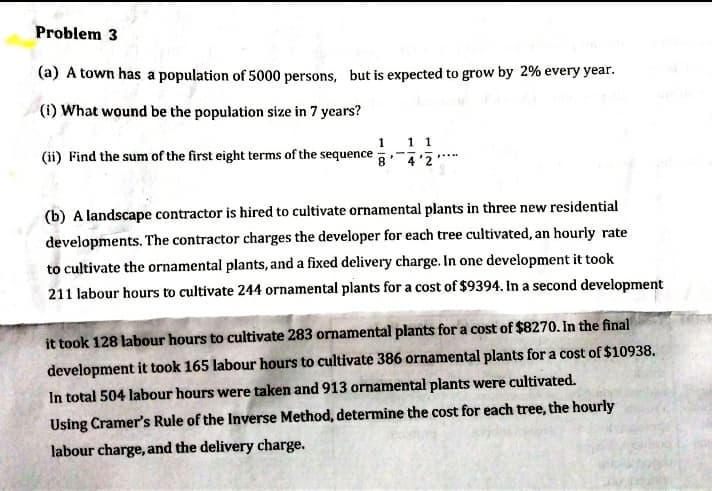Problem 3 (a) A town has a population of 5000 persons, but is expected to grow by 2% every year. (i) What wound be the population size in 7 years?
Problem 3 (a) A town has a population of 5000 persons, but is expected to grow by 2% every year. (i) What wound be the population size in 7 years?
Algebra and Trigonometry (MindTap Course List)
4th Edition
ISBN:9781305071742
Author:James Stewart, Lothar Redlin, Saleem Watson
Publisher:James Stewart, Lothar Redlin, Saleem Watson
Chapter13: Sequences And Series
Section13.FOM: Focus On Modeling: Modeling With Recursive Sequences
Problem 6P
Related questions
Question
Kindly assist thank you

Transcribed Image Text:Problem 3
(a) A town has a population of 5000 persons, but is expected to grow by 2% every year.
(i) What wound be the population size in 7 years?
1 1 1
8
(ii) Find the sum of the first eight terms of the sequence
4'2
(b) A landscape contractor is hired to cultivate ornamental plants in three new residential
developments. The contractor charges the developer for each tree cultivated, an hourly rate
to cultivate the ornamental plants, and a fixed delivery charge. In one development it took
211 labour hours to cultivate 244 ornamental plants for a cost of $9394. In a second development
it took 128 labour hours to cultivate 283 ornamental plants for a cost of $8270. In the final
development it took 165 labour hours to cultivate 386 ornamental plants for a cost of $10938.
In total 504 labour hours were taken and 913 ornamental plants were cultivated.
Using Cramer's Rule of the Inverse Method, determine the cost for each tree, the hourly
labour charge, and the delivery charge.
Expert Solution
This question has been solved!
Explore an expertly crafted, step-by-step solution for a thorough understanding of key concepts.
Step by step
Solved in 2 steps

Knowledge Booster
Learn more about
Need a deep-dive on the concept behind this application? Look no further. Learn more about this topic, algebra and related others by exploring similar questions and additional content below.Recommended textbooks for you

Algebra and Trigonometry (MindTap Course List)
Algebra
ISBN:
9781305071742
Author:
James Stewart, Lothar Redlin, Saleem Watson
Publisher:
Cengage Learning

Algebra & Trigonometry with Analytic Geometry
Algebra
ISBN:
9781133382119
Author:
Swokowski
Publisher:
Cengage

College Algebra
Algebra
ISBN:
9781305115545
Author:
James Stewart, Lothar Redlin, Saleem Watson
Publisher:
Cengage Learning

Algebra and Trigonometry (MindTap Course List)
Algebra
ISBN:
9781305071742
Author:
James Stewart, Lothar Redlin, Saleem Watson
Publisher:
Cengage Learning

Algebra & Trigonometry with Analytic Geometry
Algebra
ISBN:
9781133382119
Author:
Swokowski
Publisher:
Cengage

College Algebra
Algebra
ISBN:
9781305115545
Author:
James Stewart, Lothar Redlin, Saleem Watson
Publisher:
Cengage Learning

Intermediate Algebra
Algebra
ISBN:
9781285195728
Author:
Jerome E. Kaufmann, Karen L. Schwitters
Publisher:
Cengage Learning